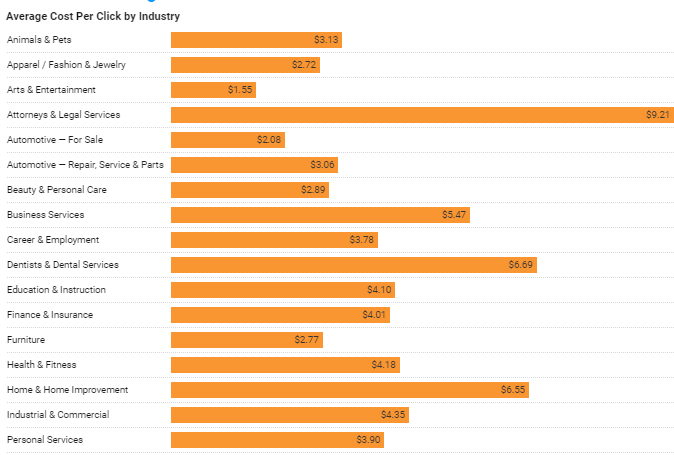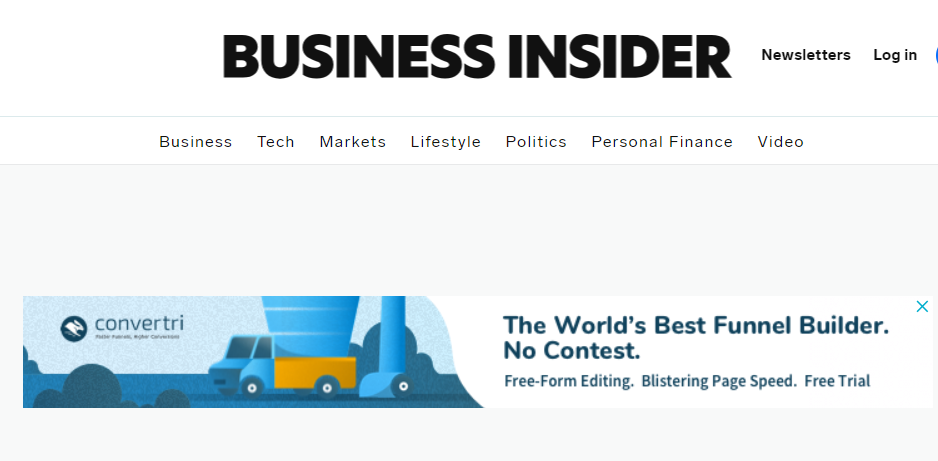Over the past few years, the digital sphere has become an indispensable part of our lives. Businesses have shifted their focus towards online marketing strategies to reach a wider audience. But there are millions of businesses operating online, and competition has gotten fiercer by the day.
Every business tries to clamor for the attention of its target audience, and the best way to ensure this is to appear on the first page of Google search results. Since only 0.63% of Google searchers click on results from the second page, not being on the first page basically means losing almost all your customers.
However, not every business can organically rank on the first page, which is where Google Ads comes in. It's a pay-per-click (PPC) advertising platform that allows businesses to bid on keywords and appear at the top of the search results page.
Here's how it works.
What Is Google Ads?
Google Ads is an online advertising platform developed by Google where businesses can create and manage advertisements. Businesses can use Google Ads to reach people who are interested in their products and services.
According to Google, you can use Google Ads to ''promote your business, help sell products or services, raise awareness, and increase traffic to your website.''
You manage your Google Ads account online. So, you have the flexibility to create and adjust ads, choose target audiences, set budgets, and track performance all in one place.
As for the budget, there's no minimum spending commitment. You can set your budget and control it according to your campaign.
How Does a Google Ad Appear
A Google ad appears when a user searches for a relevant keyword. It's like a regular search result but with the words ''*Ad'' *or ''Sponsored'' above the website's link.

Google Ad
Why Advertise With Google Ads
Google gets 40,000 search queries per second, which equals 3.5 billion searches daily. With such a massive influx of traffic, there's a very high chance of your ad being seen by potential customers.
Here are some other reasons advertising with Google Ads is a good idea:
Reaching Marketing Goals
Every business has some specific marketing goals. For one, it may be getting more phone calls to their local business. For another, it could be selling products through their e-commerce website.
Whatever the goal may be, Google Ads helps you inch closer to it. Some marketing goals you can accomplish with Google Ads include:
- Increasing website traffic
- Getting more phone calls
- Driving more sales
- Raising brand awareness
- Increasing website action (e.g. filling out a contact form or subscribing to a newsletter)
Keyword Targeting
Google Ads are rich in keywords. Using the right keywords boosts your chances of having your ad shown to relevant audiences.
Google also has responsive search ads in which the search engine's AI algorithm automatically chooses the best-performing combination of keyword-rich headlines and descriptions to show to users.
Controlled Budgeting
Google says that you ''pay only when someone interacts with your ad, like clicking your text ad or watching your video ad.''
So, it's up to you to decide how much you want to spend. There's no minimum. You can start small and increase your budget as you see results.
Ad Performance Measurement
Google's performance reports enable you to see how your ads are doing and with what audience. You can use this data to make relevant changes and improve results.
Cross-Platform Advertisements
With Google Ads, you can reach customers across platforms. These ads appear on their computers, mobile phones, tablets, and even apps.
How Does Google Ads Work?
Google Ads has three key players:
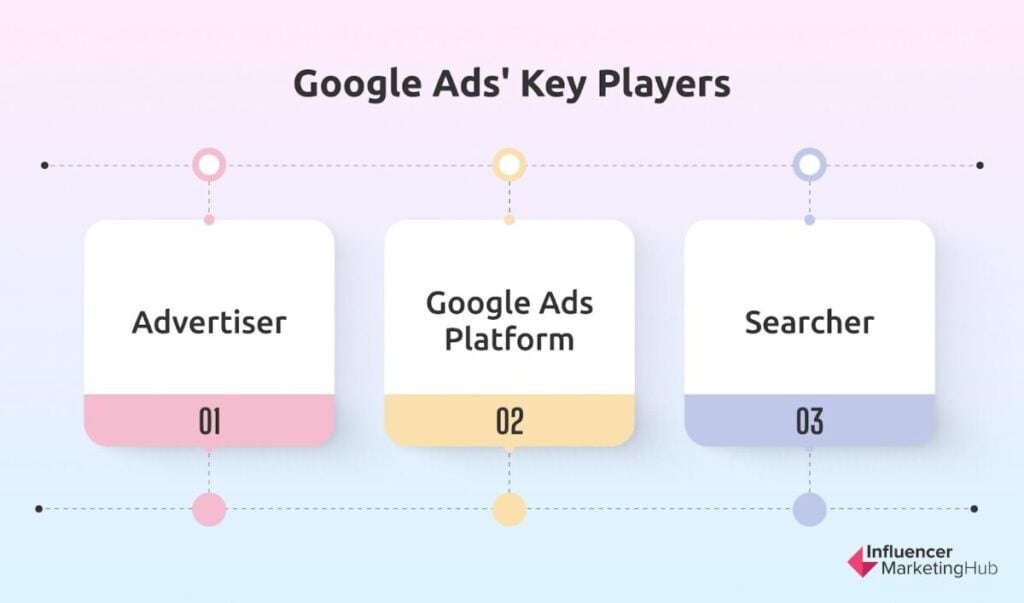
Google Ads key players
- Advertiser (your business)
- Google Ads platform
- Searcher (target audience)
Here's how these players come together to make Google Ads work.
Advertiser Bidding
The advertiser bids on the keywords or phrases they want to target. The bidding system is based on a cost-per-click (CPC) basis, meaning the advertiser only pays when someone clicks on their ad.
The keyword bids cost more or less depending on the competition. So, highly competitive keywords require a higher bid to have your ad shown.
Suppose you're an advertiser for a project management software company. You target the keyword ''*Project Management Software'' *and set a maximum cost-per-click bid of $1.50.
If someone clicks on your ad, you'll be charged up to $1.50 for that click.
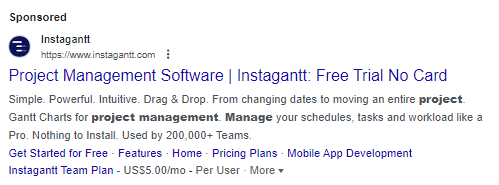
Google Ad
Audience Searching
Let's take the same example forward. Someone searches for the keyword ''*Project Management Software'' *on Google.
They will see your ad on top of the search results. Sometimes, there are multiple ads. The position of your ad will vary depending on your bid and ad performance.
Google Ads Displaying
The third key player, Google Ads, comes in here. It shows the ads based on their ad rank.
Google calculates ad rank based on the availability of spaces in search engine page results (SERPs). Advertisers get first, second, third, and so on positions based on their ad rank.
The higher the ad rank, the better the ad's position on the SERP.
How Much Does Google Ads Cost?
The cost of your Google Ads campaign depends on various factors:
- Your bidding strategy
- The competitiveness of your keywords
- Niche
- Ad quality and relevance
- The targeted audience.
For search ads, you can expect to pay anywhere from $1 to $2 per ad. Display ads cost a little less than this.
However, if you're in a highly competitive industry, such as insurance, the CPC can go as high as $50 per click.
For example, when we searched for ‘’insurance companies in New York,’’ the first four results were ads, indicating a high competition for this keyword. So, the CPC for it would be high, too.
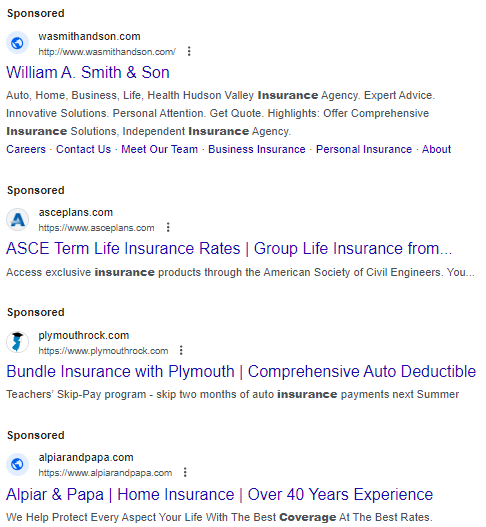
Ads about insurance companies
The amount you spend on Google Ads isn't fixed. It can fluctuate depending on your budget. One month, you can have a budget of $500, and in another month, you can increase it to $1000.
Also, remember that the CPC isn't a flat rate. It changes depending on your ad's position and cost-per-click bids from other advertisers.
Types of Google Ads
Google Ads offers a variety of ad types depending on your use case and industry. Every type is displayed on one or multiple Google properties, such as Google Shopping, YouTube, Play Store, Google SERP, etc.
Let's take a look at ad types and their examples.
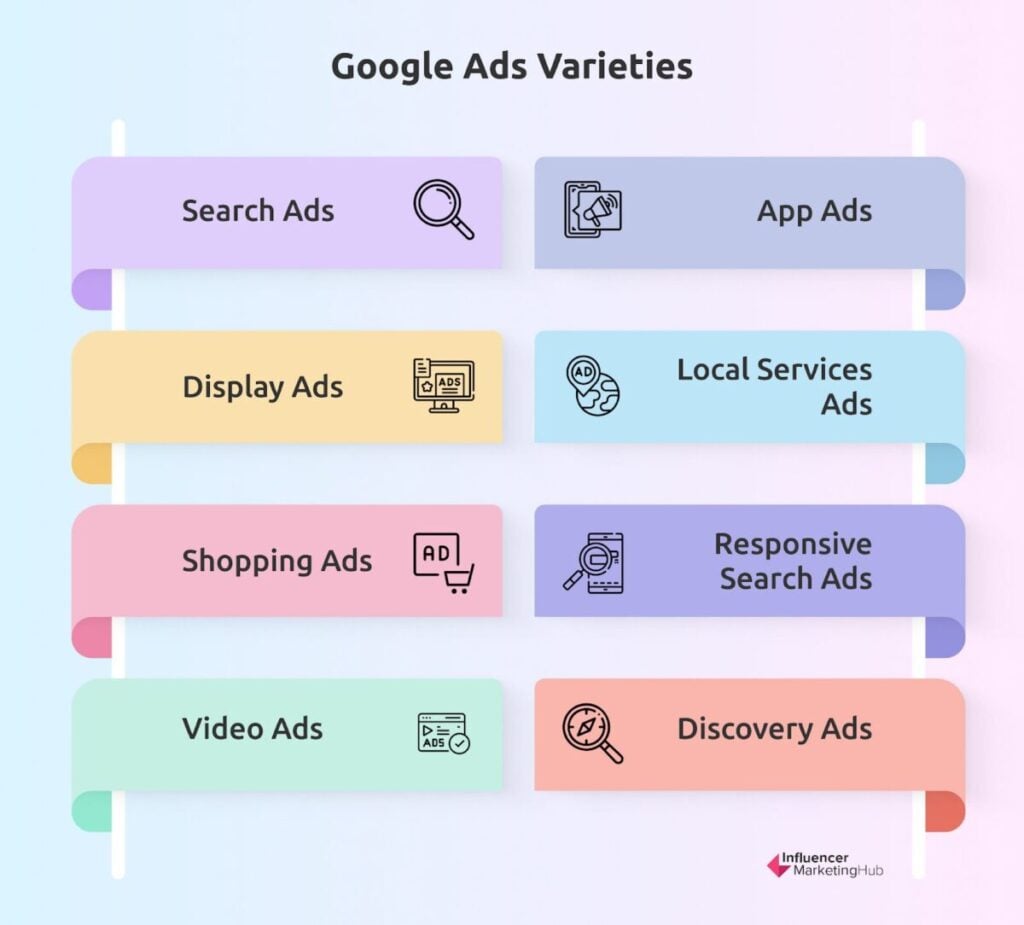
Google Ads types
1. Search Ads
Best For: Promoting a web page for a targeted keyword
As the name gives away, these ads appear in Google search results when users type in related keywords.
For example, if you search for "running shoes" on Google and see ads from Nike or Adidas at the top of the search results page without any images, they will be search ads.
These ads are a sub-type of text ads. They only have a description and no visuals.
The key features of these ads are:
- Keyword targeting
- Real-time search result
- Text-based
- Cost-efficient
Components of a Search Ad
Since a search ad is text-based, it only shows text. Usually, there's a website name, a headline, a description, a page title tag, a favicon, and a link.
Example of a Search Ad
We searched for ''scented bath bombs'' and found this search ad from Walmart. As you can see, it's solely textual.

search ad
The ad description tells you the service features, such as no membership fee and free 2-day shipping.
2. Display Ads
Best For: Creating brand awareness for new audiences
A display ad is a more visual ad type that can appear on various Google properties such as Gmail and other websites. These ads have visuals or images along with text to grab the user's attention.
Have you ever felt like you searched for something once, and now you see ads for that product everywhere? That's because display ads sort of follow you around.
Suppose you search for budgeting tips. Then, you go on to read a Forbes article on your phone. Bam! You see an ad for a budgeting app above the article title.
These ads are also known as banner ads and can come in various sizes and formats, including static images, animated GIFs, etc.
Components of a Display Ad
The ad usually has a visual, a headline, a description, and a destination URL.
It also has an option for the user to interact with it by clicking or hovering over it. You can close the ad or give feedback on it.
Example of a Display Ad
We searched for ''budgeting tips for the holidays'' and found this ad on Business Insider's home page. As you can see, there's an animated image, with the brand name along with a short headline and description.
When we clicked on the cross icon on the ad, it showed us two options: stop seeing this ad and why this ad. The former would make the ad go away, while the latter showed us an explanation of why the ad was targeted at us.
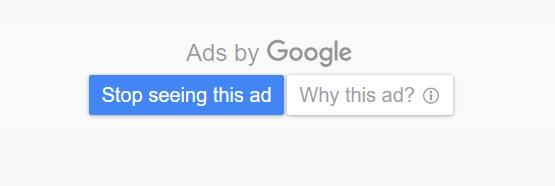
Display ad options
Here’s why Google said we were getting this ad.

Why this ad on Google
3. Shopping Ads
Best For: Selling physical products in your Google Merchant Center
Google Shopping ads are relatively newer but quite popular. They appear in the Google Shopping tab. You may also see them in SERPs, Maps, Images, and Google's search partners' results.
Google auto-populates these ads using the information and images from your Google Merchant Center. So, you must ensure you've filled in complete information for your product.
Components of a Shopping Ad
A Shopping ad includes a picture of the product along with its price, user ratings, name, brand name, and sale notice (if any).
Rather than a creative copy like in Search and Display ads, the focus here is on the product's main attributes. Keywords are still important. So, you should add them in your product's name.
Example of a Shopping Ad
Shopping ads usually appear when you search for specific physical products. So, we searched for ''dog mattress'' and found the following Shopping ads on top of the Image search results.
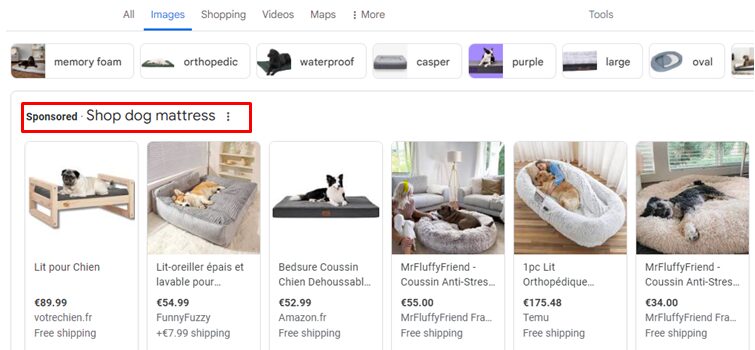
Google Shopping ads
4. Video Ads
Best For: Driving brand awareness and engagement
Video ads are shown on YouTube, Google's Display Network, and partner apps. They can be in-stream (playing before or during a video), out-stream (playing within an article), or discovery (showing up as related videos).
Besides YouTube, you may also see them in third-party apps and games. There are six types of video ads:
- Skippable In-Stream Ads: These ads play before, during, or after a video and let viewers skip them after five seconds.
- Non-skippable In-Stream Ads: These ads are short and usually play before a video. Viewers cannot skip them, so use them wisely. They are 20 seconds long at max.
- Bumper Ads: These are short, non-skippable ads of up to six seconds that play before, during, or after a video.
- In-Feed Ads: These ads appear in the YouTube Home Feed, Subscription Feed, and Watch Next.
- Outstream Ads: These are like Display ads that play on Google's video partner networks.
- Masthead Ads: They are similar to banner ads and appear on the top of your YouTube feed. They are pricey and best for promoting a big product launch or event.
Components of a Video Ad
A video ad contains a video, to no one's surprise. It also contains other elements like a thumbnail, a title, a description, and a call to action.
Example of a Video Ad
We searched for the keyword ''how to clean your studio apartment'' and came across this ad for Wix Studio. As you can see, the video does most of the work. The title and description are extremely concise. This is an example of an in-feed ad.

video ad
Then, we clicked on the first video for your search query. An ad for Grammarly played before the video. It was a skippable ad with a clear call to action and a skip button, which appeared after 5 seconds of the ad playing.
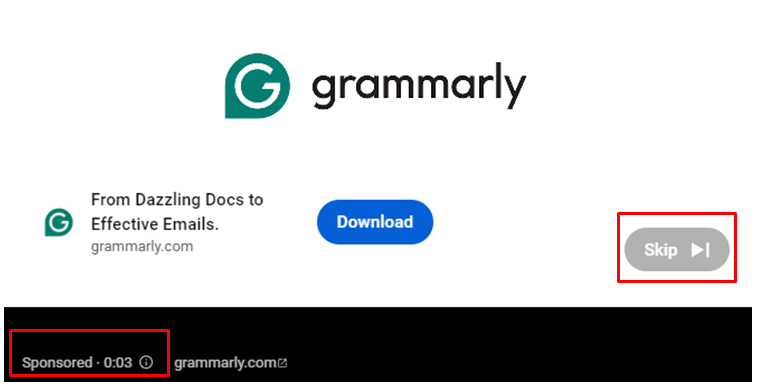
video ad
5. App Ads
Best For: Promoting a new (Android) or existing app
App ads allow you to advertise your app on Google and its search partners. They look like a typical ad but have an ''Install'' or ''Open'' button instead of the landing page's link.
These ads appear in Play Store suggestions, YouTube feeds, Google Discover, Google SERPs, and Play Store search results. You'll also see them on Google's search partner networks.
App ads serve three purposes:
- Installs: The main goal of this ad is to increase the number of app installs.
- Engagement: The secondary objective is to boost user engagement with your app.
- Pre-Registrations: Apps or games that you haven't launched yet can use this ad type to pre-register interested users.
Components of an App Ad
An app ad will have a headline and a description like a search ad. There's an ''Install App'' call-to-action (CTA) button at the bottom. If the user already has your app installed, the CTA becomes ''Open.''
Underneath the app headline are the app's ratings, along with the number of reviews.
Example of an App Ad
App ads appear when you search for app-related keywords. For example, if you need an app for time management, you'll likely see ads for productivity apps like ''Todoist'' and ''Evernote.''
We searched for ''photo editing app'' in the Google Play Store. The top result was a sponsored app.
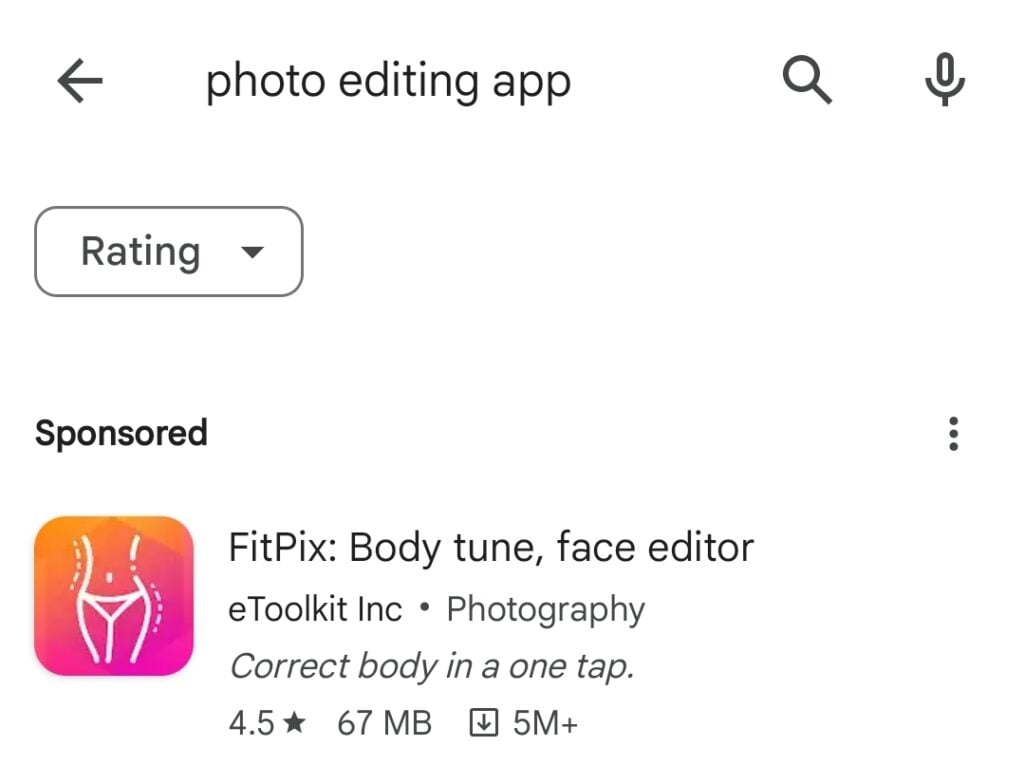
app ad
6. Local Services Ads
Best For: Advertising a local business
Although Local Service ads aren't found in the Google Ads hub, they're still a type of Google ad, so we'll cover them.
Local Service ads are geared toward local businesses. They appear in Google Maps and SERPs.
Components of a Local Service Ad
A Local Service ad shows the business's name, location (on Map), ratings, hours of operations, and contact information.
Example of a Local Service Ad
Local Service ads usually appear when you make ''near me'' searches. For example, if you search for ''nail salons near me,'' you might come across an ad for a nearby nail salon.
We searched for ''law firms in New York'' and the top two results were ads. Besides the firms' information, these ads also point the searcher to their website and directions.
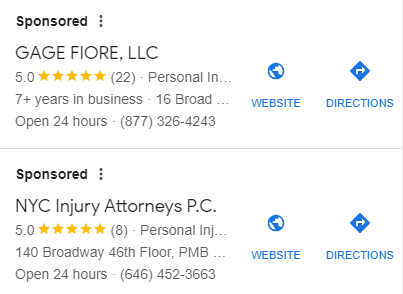
local service ad
7. Responsive Search Ads
Best For: Finding the best combinations of your ad's headlines and descriptions
Responsive Search Ads (RSAs) automatically create different combinations of your ad's headlines and descriptions to find the most effective one. Here's how they work:
- You input 15 headlines and 4 descriptions for each ad.
- Google's AI takes these assets and creates multiple combinations of headlines and descriptions.
- The AI then tests them against different search queries and shows the most relevant combination to each searcher.
You can also pin specific headlines and descriptions to certain positions in your ad. This allows you to maintain control over certain key messages while still allowing the AI to test different combinations.
Components of a Responsive Search Ad
A responsive search ad has a headline and a description. These ads may show one, two, or three headlines. Similarly, there may be more than one description in the ad.
Example of a Responsive Search Ad
We searched for ''real estate firms in New York'' and came across this responsive search ad. As you can see, it has two headlines. The advertiser may have pinned ''NYC Real Estate'' to headline 1 to ensure that their ad always shows their location.
In the description, you can see that New York is in bold. It's because when there's an exact keyword match, Google bolds it in the ad.
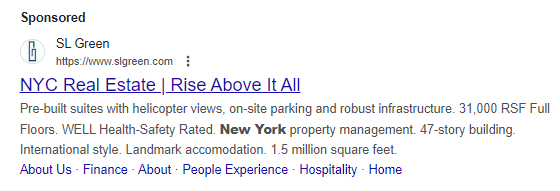
search ad
Similarly, we searched for ‘’European medical treatment in NYC.’’ In the ad below, you can see that our keyword is in bold.
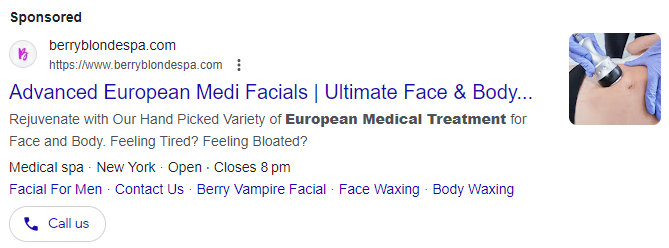
responsive search ad
The ad also shows a Call us option, which would allow the searcher to make calls on devices that support phone calls.
8. Discovery Ads
Best For: Targeting users who are ready to make a purchase and need a final push
Discover ads are shown in the Google Discover feed above the Explore section. These ads appear in the form of a native banner and are meant to blend in with the other content on the Discover feed.
Google uses machine learning to tailor these ads to your audience. They can also appear in Gmail and YouTube. Discovery ads usually contain multiple images.
Components of a Discovery Ad
A Discovery ad typically includes multiple images, a headline, a copy, a business name, and a logo.
Example of a Discovery Ad
Ted Baker, a UK fashion brand, uses Discovery ads to showcase its collections to potential customers. As a result of its 2020 Discovery ad campaign, the brand saw a 70% increase in revenue generation.
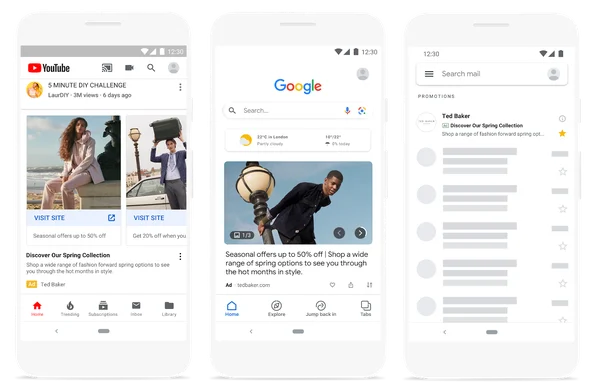
discovery ads
How to Choose the Right Ad Type
Consider the following factors when choosing the right ad type for your business:
- Business Goals: What do you want to achieve with your ads? Do you want more website traffic, increase in sales, or more calls?
- Target Audience: Who are you trying to reach with your ads? Different ad types have different targeting options. For example, video ads are more suited for audiences that are active on YouTube while search ads are better for those using Google's search engine.
- Ad Budget: How much are you willing to spend on your ads? Some ad types like Display and Video ads may require a higher budget compared to search ads.
According to Google, here's how you should match business goals with ad types:
- Search: To boost sales and signups
- Responsive Search: To find new customers and increase conversions
- Display: To drive sales and increase brand awareness
- Video: To drive conversions, boost brand awareness, and expand your reach
- App: To promote your apps and dabble in multi-channel marketing
- Shopping: To get sales and leads or boost a local store to nearby people
Conclusion
There you have it — a comprehensive guide on Google Ads along with the ad types and their examples. Due to Google's widespread use, Google Ads is an effective medium to reach existing and new audiences, increase sales, enhance brand awareness, and generate leads.
You can use the Google Ads hub to show ads in every Google property from SERPs to the Discovery tab. So, explore your options and choose the ad campaign that best serves your brand's objectives.
